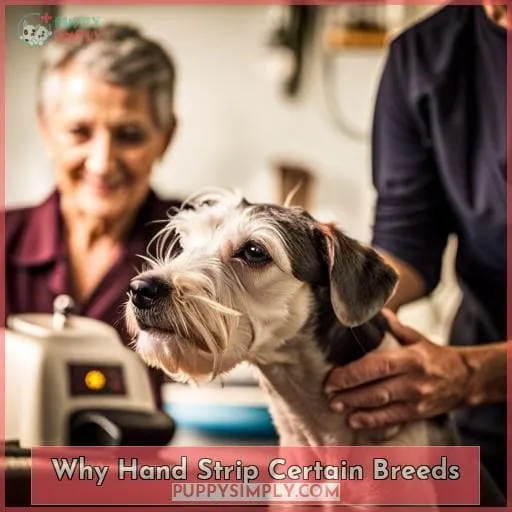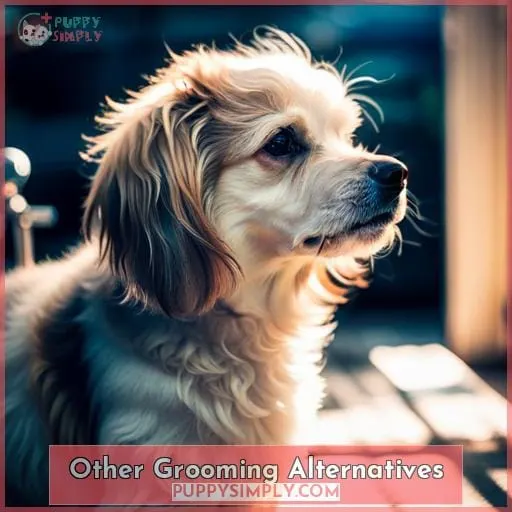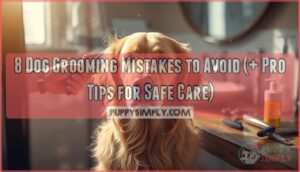This site is supported by our readers. We may earn a commission, at no cost to you, if you purchase through links.

Do you wish there was an easier way to groom your furry friend?
Look no further!
In this article, we’ll uncover the secrets of alternative grooming methods,
revealing the risks of clippering and
introducing you to a world of options beyond hand stripping.
Get ready to transform your grooming routine and make it a breeze!
Table Of Contents
- Key Takeaways
- Why Hand Strip Certain Breeds
- Clippering Instead of Hand Stripping
- Other Grooming Alternatives
- Educating Clients on Hand Stripping
- When Hand Stripping Can’t Be Done
- Frequently Asked Questions (FAQs)
- How often should hand stripping be done for my dog’s breed?
- What are the signs my dog’s coat needs to be hand stripped?
- What is the cost difference between hand stripping and clipping my dog?
- Will my dog be uncomfortable during the hand stripping process?
- Is it possible to learn to hand strip my dog at home or do I need a professional groomer?
- Conclusion
Key Takeaways
- Use thinning shears or Coat King tool instead of clippers to minimize coat damage.
- Inform clients of grooming options before clipping coats that need stripping.
- Compromise by blending clipped and stripped areas to balance client wishes and coat risks.
- Educate clients on the importance of hand stripping for certain breeds to avoid permanent coat changes.
Why Hand Strip Certain Breeds
You must hand strip breeds like terriers and schnauzers rather than clipping them.
The process stimulates healthy coat growth and maintains proper coat texture.
Neglecting hand stripping can cause the coat to become soft, fluffy, and dull over time.
For these wiry coated breeds, hand stripping is vital for coat health and shouldn’t be substituted with clipping.
Stimulates Healthy Coat Growth
Through hand stripping, you’re stimulating the skin and follicle for new, healthy regrowth of the proper textured coat.
The timing of hand stripping depends on factors like the dog’s breed, coat type, and individual needs.
Consult a professional groomer for guidance on the optimal frequency for hand stripping to maintain coat health.
Consider clippers or alternatives like thinning shears for breeds requiring less intensive stripping.
Evaluating each dog’s specific requirements leads to the best grooming approach.
Maintains Proper Coat Texture
Another reason you should hand strip certain breeds is it maintains their proper coat texture.
- Preserves coat health and texture
- Considers grooming preferences
- Provides breed-specific care
Educates clients on clippering risks
Explores grooming options and alternative techniques
Clippering Instead of Hand Stripping
When opting to clipper a breed that should be hand stripped, use a skip tooth blade to minimize coat damage.
Clipping risks permanently altering coat texture and color over time, so inform clients about grooming options before making this decision.
Consider referring clients to groomers offering hand stripping if your salon’s policy prohibits it.
Clipper Blades to Use
When you’re clippering instead of hand stripping, you’ll want to use skip tooth blades that leave some coat behind rather than close shaving.
Choosing the right clipper blade is crucial, as the wrong choice could permanently damage coat texture. Skip tooth blades allow some of the harsh outer guard hairs to remain, maintaining proper coat texture better than a close shave.
Regular clipper maintenance and blade changes are key for grooming safety, preventing irritation.
Alternative tools like thinners or the Coat King tool can also help minimize clipping risks when hand stripping certain breeds isn’t an option.
Risk of Coat Damage
You’re risking permanent damage to the coat texture and color when you clip instead of hand strip.
Understandably, hand stripping certain breeds takes skill and time. However, using clippers can irreversibly affect coat integrity, damaging texture and preservation.
When faced with grooming dilemmas involving breeds requiring hand stripping, educate clients on alternative techniques respecting aesthetic preferences.
Compromise solutions balance client wishes with coat damage risks, utilizing methods preserving hand-stripped appearance.
Other Grooming Alternatives
Other grooming alternatives exist besides clippering.
Using thinning shears and the Coat King tool can help maintain the coat texture and length.
These methods allow you to avoid clippering while still removing dead hair and undercoat.
Thinning Shears
Having covered the risks of clippering instead of hand stripping, consider using thinning shears as an alternative method for grooming certain breeds that require hand stripping while avoiding potential coat damage from clipping.
- Carefully trim just the ends of longer topcoat hair with thinning shears.
- Use thinning shears to blend clipped areas into hand-stripped areas.
- Go slowly and carefully to avoid cutting the coat too short.
- Work in layers using thinning shears then card out undercoat as needed.
- Consult an experienced groomer on proper thinning shear techniques for the breed.
Coat King Tool
Another alternative grooming option to consider is using a Coat King tool to maintain the coat instead of hand stripping.
This precision grooming tool with rotating teeth can help DIY groomers mimic professional hand stripping techniques for coat maintenance without the challenges of actually hand stripping.
While not a full replacement, the Coat King helps smooth longer hairs and maintain the proper coat texture to avoid clippering risks like permanent damage.
It allows owners to keep up with grooming needs between professional appointments.
Educating Clients on Hand Stripping
As a groomer, you have an obligation to properly inform your clients.
Provide pictures showing clipped versus hand-stripped coats to demonstrate the drastic differences.
Make clear the potential consequences of clipping certain breeds so owners can make an educated decision between hand-stripping or clipping.
Importance for Certain Breeds
One important aspect is educating clients on the importance of hand stripping for certain breeds.
As experts, groomers should inform clients that breeds like Schnauzers, Welsh Terriers, and Wirehaired Pointing Griffons have specific coat needs.
When unable to hand strip, discuss clippering risks and alternative grooming options to meet the breed’s needs and the client’s wishes.
Pictures Showing Differences
Illumination on the distinctions comes from presenting clients with photographic evidence of correctly hand-stripped coats beside inappropriately clipped ones.
You’re then able to clearly showcase the risks of clipping.
Comparative images demonstrate the visual contrast between proper hand stripping and inferior clippering, empowering you to educate clients on the grooming transformations.
Side-by-side comparisons and before-after shots spotlight the clippering risks and reinforce why alternative grooming options should be considered for certain breeds requiring hand stripping to maintain their signature wire coats.
When Hand Stripping Can’t Be Done
Despite your best efforts to educate clients, sometimes hand stripping just can’t be done.
Certain corporate grooming salons prohibit the practice due to time constraints, liability concerns, or lack of skilled groomers. Some clients simply don’t wish to pay the extra cost or go through the lengthy process.
When hand stripping isn’t possible, focus on minimizing damage through proper clipper blade selection and techniques.
Alternatively, carding, thinning shears, or stripping knives can remove some excess coat while maintaining more texture.
While not ideal, these modified techniques help retain the breed profile when hand stripping isn’t an option.
Frequently Asked Questions (FAQs)
How often should hand stripping be done for my dog’s breed?
The frequency of hand stripping depends on your dog’s breed and coat type.
Typically, every 4-8 weeks works well, but some breeds with dense coats may need it more often.
Consulting a professional groomer is your best bet to determine the ideal schedule for maintaining your dog’s coat health.
What are the signs my dog’s coat needs to be hand stripped?
Look for a dull, brittle coat with fading color.
Excess shedding and matting also indicate it’s time for stripping.
The coat should appear healthy, glossy, and vibrant when properly stripped.
What is the cost difference between hand stripping and clipping my dog?
Hand stripping can cost six times more than clipping due to the extra time and skill required.
Discuss the cost difference with your groomer to determine if hand stripping is right for your budget and your dog’s needs.
Will my dog be uncomfortable during the hand stripping process?
Hand stripping can cause mild discomfort, but an experienced groomer works gently and takes breaks to avoid irritating your dog’s skin.
Staying calm and providing praise helps your dog relax during the process.
Proper technique prevents any significant pain.
Is it possible to learn to hand strip my dog at home or do I need a professional groomer?
You can learn to hand strip at home with practice and patience.
Invest in quality tools and watch tutorials.
Go slowly, work in small sections, and give your dog breaks.
For best results, have an experienced groomer teach you proper technique.
Conclusion
Finding yourself frustrated after yet another hand stripping session? Barbara can relate.
After years of painful grooming, she finally tried a thinning shear and never looked back.
You don’t have to hand strip. With some education on alternatives like clippering and tools like the Coat King, you can find a solution that works for your dog’s coat and lifestyle.
Keep an open mind, and you may just transform your grooming routine for the better.











